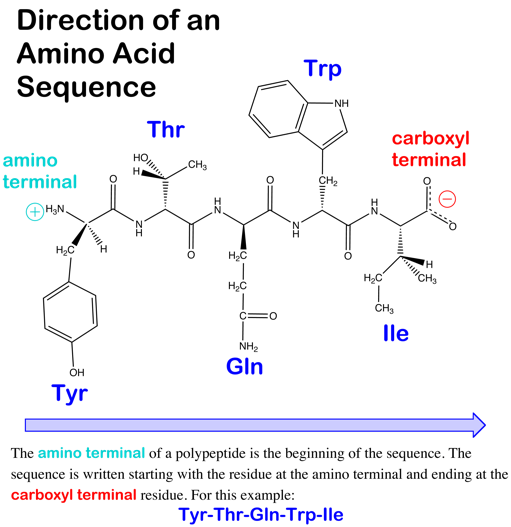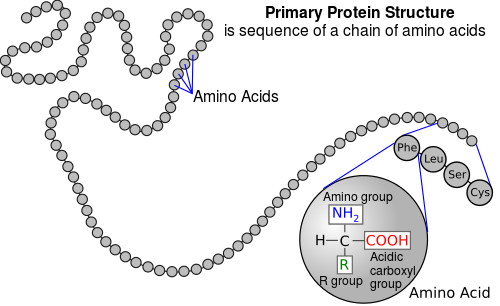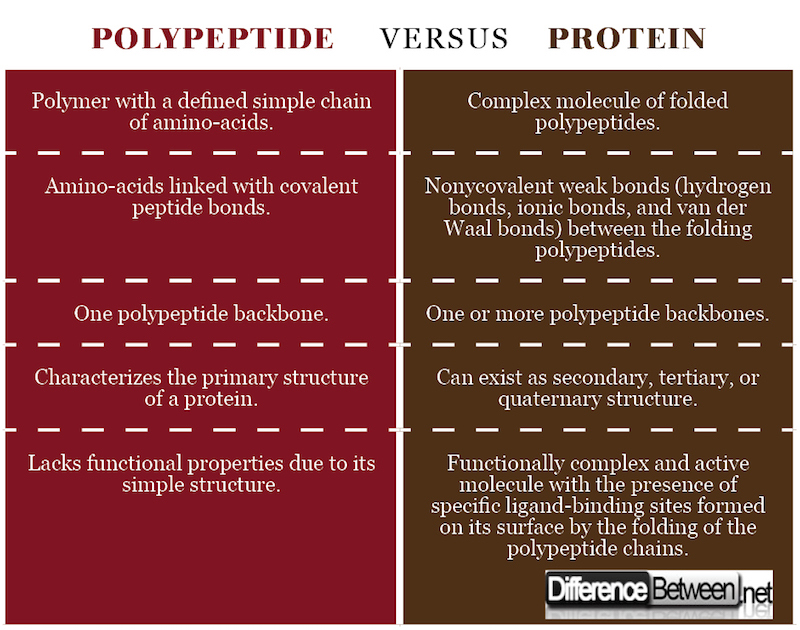Difference Between Polypeptide and Protein
Polypeptides and proteins are natural and essential organic compounds of a cell. They are both composed of amino-acids. Amino-acids are naturally occurring compounds which link together to form peptides, polypeptides, and proteins. Each amino-acid contains one amine (-NH2) and one hydroxyl (-COOH) group, as well as a specific side chain (R group). The side chain group varies in size, shape, charge, and reactivity, and is therefore unique to each amino-acid. There are 20 types of monomeric amino-acids capable of linking together in different combinations, thus conferring polypeptides and proteins with a high diversity.
What is a polypeptide?
A polypeptide is a polymer with a defined sequence of amino-acids linked together through covalent peptide bonds. A peptide bond is the result of a condensation reaction between two amino-acids: the carboxyl group of one amino-acid reacts with the amino group of an adjacent amino-acid, releasing a molecule of water (H2O). Short chains of amino-acids linked by peptide bonds are referred to as peptides. Peptides are usually formed by up to 20-30 amino-acids. Longer chains of linked amino-acid residues with a specific sequence are called polypeptides. Polypeptides can contain up to 4000 residues. Polypeptides are characterized by a polypeptide backbone formed by the repeating sequence of atoms at the core of the linked amino-acids chain. Attached to the polypeptide backbone are the amino-acids specific side chains, the R group. Polypeptides can fold into a fixed structure forming a protein. A polypeptide constitutes therefore the linear sequence of amino-acid residues that forms the primary structure of a protein.
What is a protein?
Proteins are structurally and functionally complex molecules. The term protein is used to describe the three-dimensional structure formed by the folding of one or more polypeptides. Proteins present four levels of structural organization, with the polypeptide being the primary structure. A protein has a secondary structure when polypeptide chains form α helices and β sheets. The protein tertiary structure constitutes the full three-dimensional organization of a polypeptide chain. When more than one polypeptide chain are involved in the protein complex, the protein structure is designated as quaternary. The folding of polypeptide chains to form a protein is based on many weak non covalent bonds that form between different parts of one chain or even two or more polypeptide chains. The non covalent bonds involve the atoms of the polypeptide backbone as well as the side chains R group, and are of three types: hydrogen bonds, ionic bonds, and van der Waal bonds. Large numbers of weak non covalent bonds act in parallel and their strength is combined in order to ensure the stability of a folded protein structure. A substructure of the protein organization is the protein domain. It consists of any part of a polypeptide chain that can fold independently into a stable structure. Each domain contains between 40 and 350 amino-acids. The smallest protein presents a single domain while a large protein can contain up to several dozen domains. Each domain of the protein is usually associated with a distinct function. The functional properties of proteins depend largely on their structure and shape which enable them to interact physically with other molecules. These interactions are always specific and selective. Each protein can bind with its ligand-binding sites with high affinity to one or just a few molecules known as ligands. The ligand-binding site is a cavity in the protein surface formed by the folding of the polypeptide chain. Separate ligand-binding sites in a protein can bind to different ligands, regulating the protein function, or helping to move the protein to a particular site in the cell. Protein function depends closely on its structure. A change in one amino-acid can disrupt its shape and cause a loss of function.
Difference between polypeptide and protein
-
Definition of polypeptide and protein
A polypeptide is a polymer formed by a defined sequence of amino-acids linked together through covalent peptide bonds.
A protein is a structurally and functionally complex molecule formed by the folding of one or many polypeptide chains.
-
Structural differences in polypeptide and protein
A polypeptide presents a simple structure and consists of the polypeptide backbone formed by the repeating sequence of atoms at the core of the linked amino-acids chain. Attached to the polypeptide backbone are the amino-acids specific side chains, the R group
A protein, on the other side, is a complex molecule consisting of one or more polypeptide chains folding into secondary, tertiary or quaternary structure.
The protein shape is held stable by three types of weak non covalent bonds: hydrogen bonds, ionic bonds, and van der Waal bonds.
-
Function of polypeptide and protein
The main function of a polypeptide is being the primary structure of more complex proteins. Polypeptides lack the three-dimensional structure which enables a protein to bind to a ligand and be functional.
On the other side, the structural complexity of a protein, its stable shape with its ligand-binding sites enables it to bind specifically and with high affinity to particular ligands, to be regulated, and to participate in many vital cellular metabolic pathways.
Polypeptide versus Protein: Comparioson Table
Summary of polypeptide vs. protein
Polypeptides and proteins are naturally occurring and essential organic compounds of a cell.
While amino-acids are their common primary component, polypeptides and proteins present major structural and functional differences:
- A polypeptide is a simple polymer of amino-acids linked by covalent peptide bonds, while a protein is a complex molecule characterized by a stable structure composed by the folding of one or more polypeptide chains, held together by non covalent bonds.
- A polypeptide’s main function is being the primary structure of a protein, while a protein is a complex compound, with ligand-binding sites enabling it to bind to specific and different molecules and be functionally active in the cell.
- Differences Between Irreversible Enzyme Inhibitors and Reversible Enzyme Inhibitors - May 23, 2018
- Difference Between T cells and B cells - April 5, 2018
- Difference Between Primary Pollutants and Secondary Pollutants - March 17, 2018
Search DifferenceBetween.net :
Leave a Response
References :
[0]Alberts B, Johnson A, Lewis J, et al. Molecular Biology of the Cell. 4th edition. New York: Garland Science; 2002. Protein Function. Available from: https://www.ncbi.nlm.nih.gov/books/NBK26911/
[1]Alberts B, Johnson A, Lewis J, et al. Molecular Biology of the Cell. 4th edition. New York: Garland Science; 2002. The Shape and Structure of Proteins. Available from: https://www.ncbi.nlm.nih.gov/books/NBK26830/
[2]Lodish H, Berk A, Zipursky SL, et al. Molecular Cell Biology. 4th edition. New York: W. H. Freeman; 2000. Section 3.1, Hierarchical Structure of Proteins. Available from: https://www.ncbi.nlm.nih.gov/books/NBK21581/
[3]Image Credit: https://commons.wikimedia.org/wiki/File:Aasequencedirection.png#/media/File:Aasequencedirection.png
[4]Image Credit: https://upload.wikimedia.org/wikipedia/commons/thumb/3/38/Protein_primary_structure.svg/500px-Protein_primary_structure.svg.png



